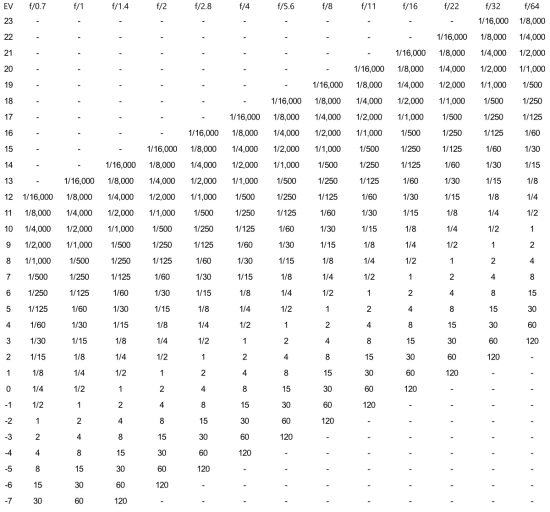Most modern cameras and light meters measure the photons of light reflected from the subject in terms of Exposure Value (EV). The greater the number of photons received, the greater the electricity that is produced by the light meter. International standards specify how much light received equals a certain EV number. This value is measured by the following number series (for ISO 100 film or digital sensor):
-7, -6, -5, -4, -3, -2, -1, 0, 1, 2, 3, 4, 5, 6, 7, 8, 9, 10, 11, 12, 13, 14, 15, 16, 17, 18, 19, 20, 21, 22, 23,
In the above table even though it appears to be a linear progression, each number represents twice as much light as the previous number as the numbers increase. This provides an easy scale to understand the value of the amount of light falling on a subject.
The light meter uses these values to calculate the combination of camera shutter speed and lens aperture. A knowledge of Exposure Value (EV) will enhance your photography and give you more control over the exposure.
The Exposure Value number must be converted into an f-stop and shutter speed combination so that proper exposure is given to the film or to the sensitivity of the sensor for the ISO which has been chosen, this calculation is done by your camera.
The relationship between Exposure Value, ISO Speed, Shutter Speed and f-stop is given by the following table for an ISO100 film or sensor.
Shutter Speed (seconds) Required for f-stop

Practical Considerations
It should be noted that all cameras or lightmeters may not cover the full range of Exposure Values, f-stops, ISO speed or shutter speeds referenced in the above table.
With film cameras, once the camera is loaded with film there are essentially two variables, the shutter speed and the lens aperture, however with digital cameras there are three variables to be considered for each exposure, the shutter speed, the lens aperture and the camera ISO setting which gives far more flexibility for the digital camera.
